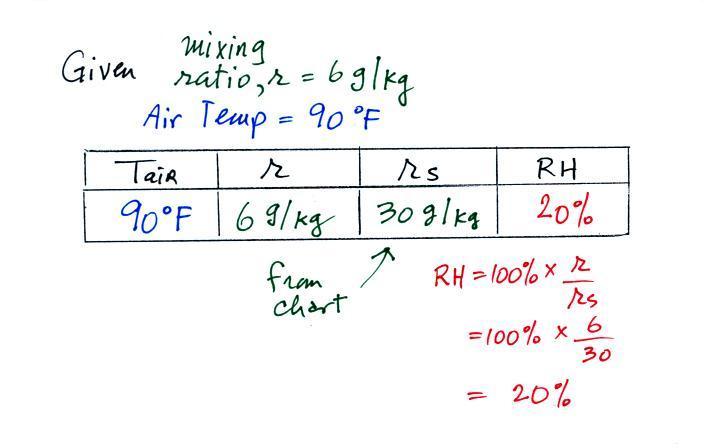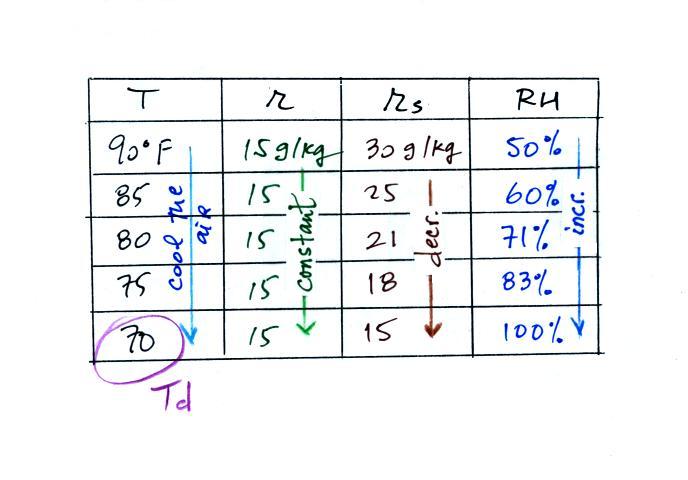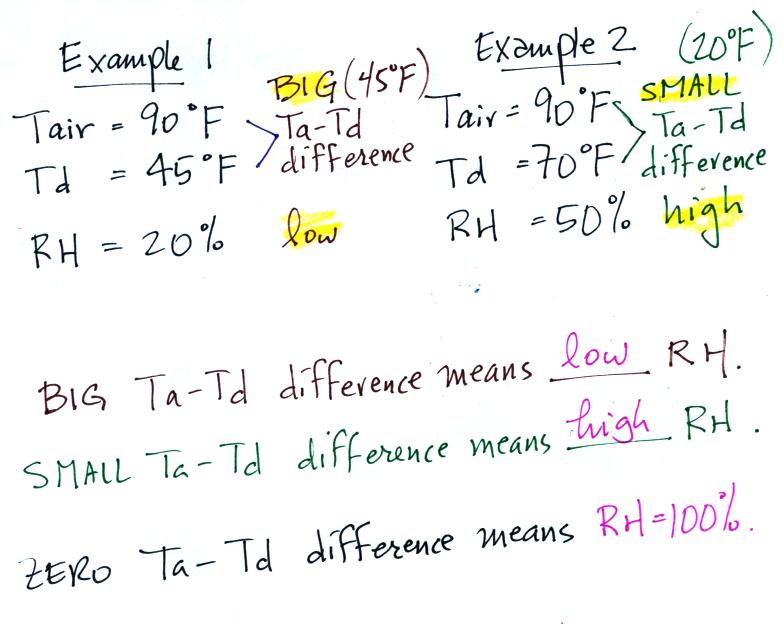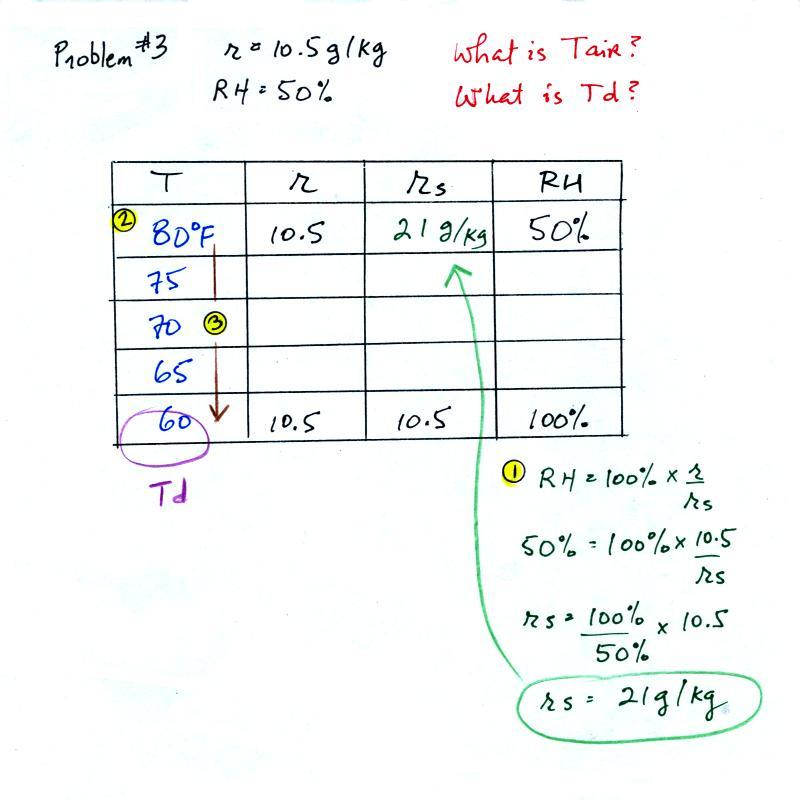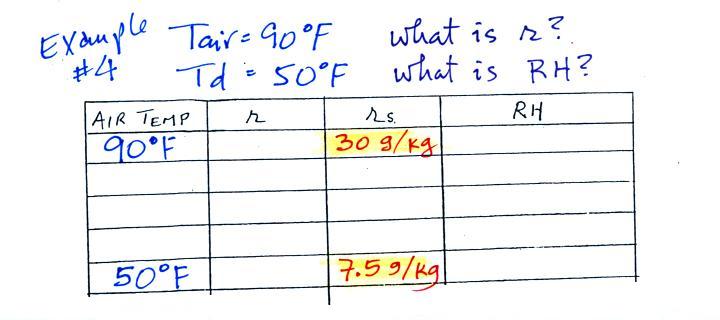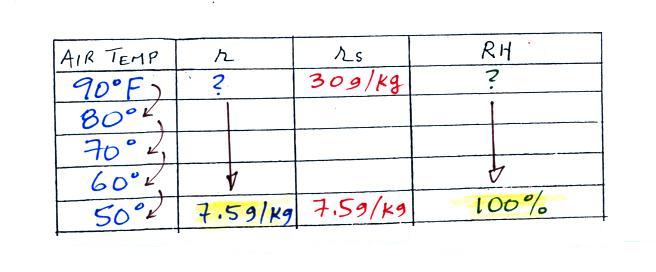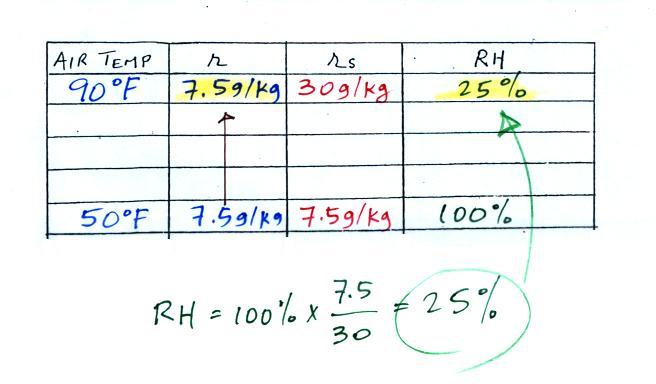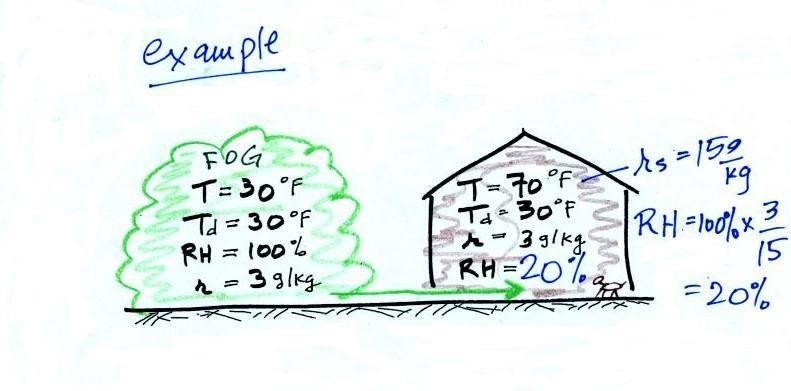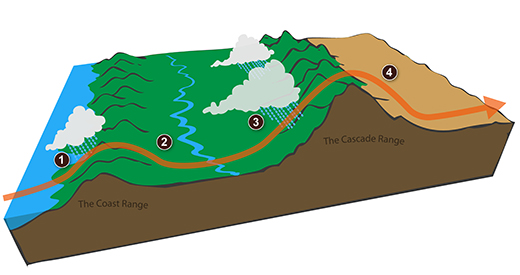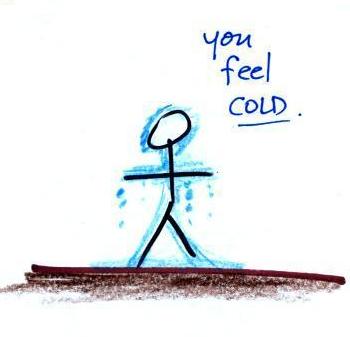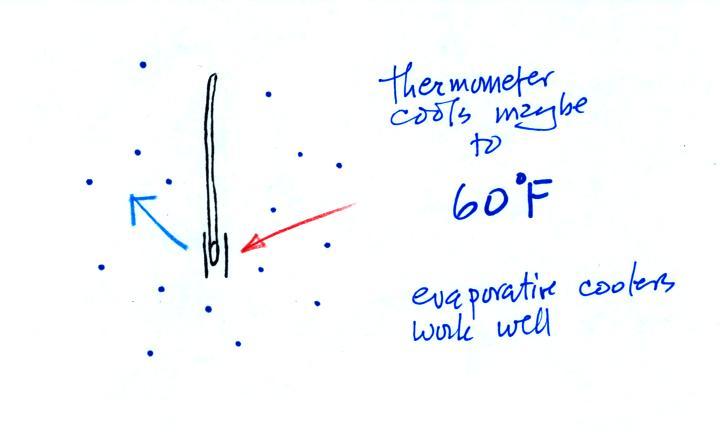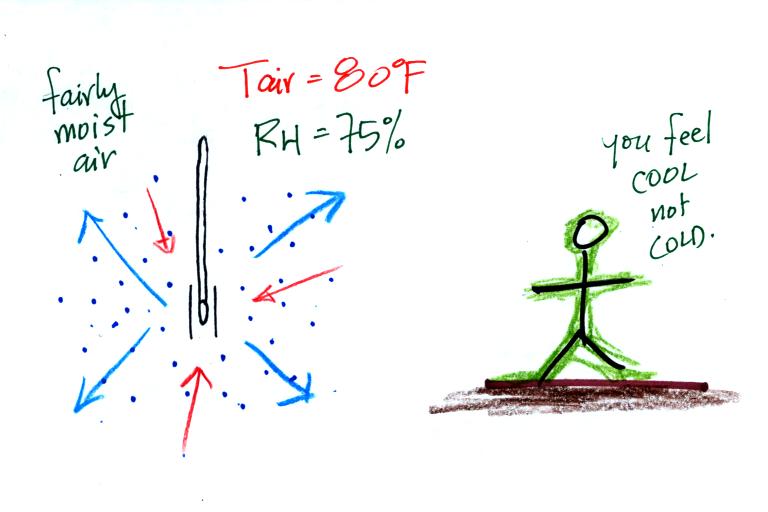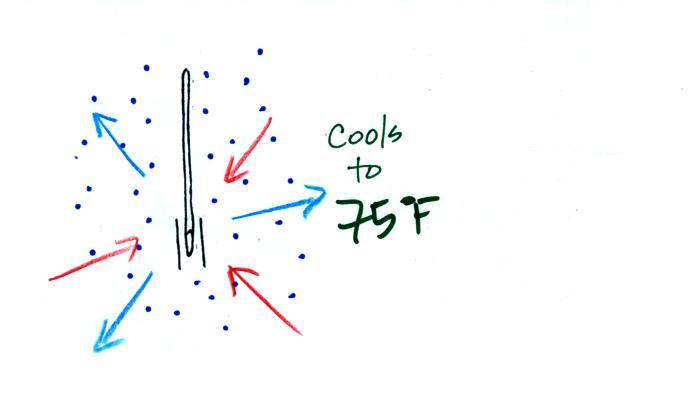Thursday March 26, 2015
Iron and Wine: "Upward Over
the Mountain", "The Night
Descending", "Jezebel",
Fleet Foxes "Tiger
Mountain Peasant Song", Willie & Lukas Nelson "My Window
Faces The South", "Just Breathe"
There are some Saturating
Air with Water Vapor notes online that I am encouraging
everyone to read. These notes attempt to explain why there
is an upper limit to the amount of water vapor that can be found
in air and why the upper limit depends on the air's temperature.
Today was the due date for the 1S1P reports on Causes of the
Seasons or the Equinoxes (you could write about one or the other
not both). Reports on Ultraviolet Light are due next
Tuesday. Unless notes otherwise, the Expt. #3 reports and
the Expt. #2 revised reports are due next Tuesday also, March 31.
A
handout with some reasonably tough humidity type questions
was distributed in class. It isn't an Optional Assignment,
rather it will give you some practice with the material that we
will be covering today. I'll put the answers online later
this week or early next week.
We worked three humidity example problems in class today.
Humidity example problem #1
You were given the air temperature and the
mixing ratio and were supposed to determine the relative
humidity and the dew point temperature.
Tair = 90 F
|
r = 6 g/kg
|
RH
= ?
|
Td
= ?
|
I'll work through the problem
carefully in a step by step way.
We start by entering the data we were given
in the table.
Anytime you know the air's temperature you can
look up the saturation mixing ratio value on a chart (such as
the one on p. 86 in the ClassNotes); the saturation mixing ratio
is 30 g/kg for 90 F air. 90 F air could potentially hold
30 grams of water vapor per kilogram of dry air (it actually
contains 6 grams per kilogram in this example).
Once you know mixing ratio and saturation mixing ratio you
can calculate the relative humidity (you divide the mixing ratio
by the saturation mixing ratio, 6/30, and multiply the result by
100%). You ought to be able to work out the ratio 6/30 in
your head (6/30 = 1/5 = 0.2). The RH is 20%.
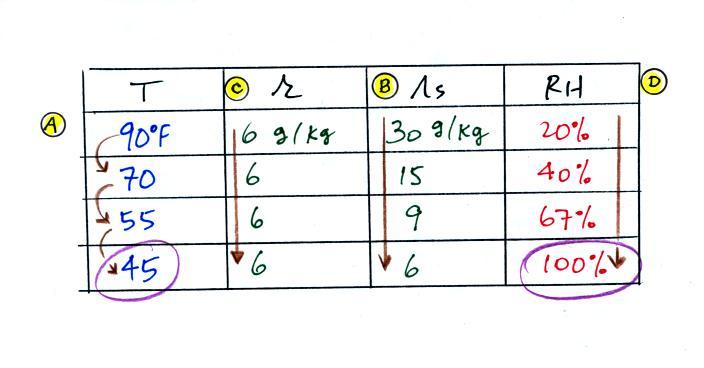
The numbers we just figured out are shown on
the top line above.
(A) We imagined cooling the air from 90F to 70F, then to
55F, and finally to 45F.
(B) At each step we looked up the saturation mixing ratio
and entered it on the chart. Note that the saturation
mixing ratio values decrease
as the air is cooling.
(C) The mixing
ratio (r) doesn't change as we cool the air. The
only thing that changes r is adding or removing water vapor and
we aren't doing either. This is probably the most
difficult concept to grasp.
(D) Note how the relative humidity is increasing as we cool
the air. The air still contains the same amount of water
vapor it is just that the air's capacity is decreasing.
Finally at 45 F the RH becomes 100%. This is the dew
point. The dew point temperature is 45 F
What would happen if we cooled the air further
still, below the dew point temperature?
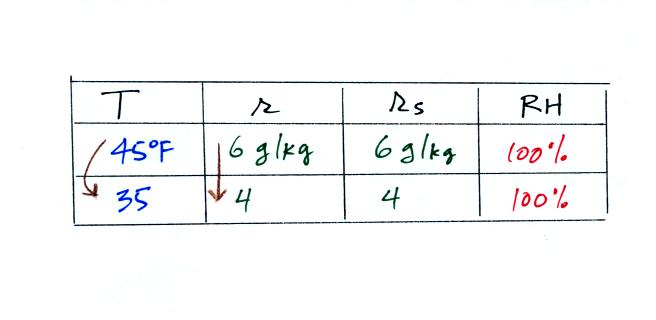
35 F air can't hold the 6 grams of water
vapor that 45 F air can. You can only "fit" 4 grams of
water vapor into the 35 F air. The remaining 2 grams would
condense. If this happened at ground level the ground
would get wet with dew. If it happens above the ground,
the water vapor condenses onto small particles in the air and
forms fog or a cloud. Because water vapor is being taken
out of the air (the water vapor is turning into water), the
mixing ratio will decrease from 6 g/kg to 4 g/kg. As you
cool air below the dew point, the RH stays constant at 100% and
the mixing ratio decreases.
In many ways cooling moist air is liking
squeezing a moist sponge (this figure wasn't shown in class)
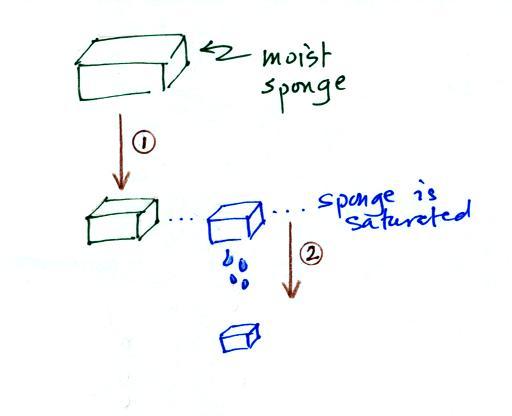
Squeezing the sponge and reducing its volume
is like cooling moist air and reducing the saturation mixing
ratio. At first (Path 1 in the figure) when you squeeze
the sponge nothing happens, no water drips out. Eventually
you get to a point where the sponge is saturated. This is
like reaching the dew point. If you squeeze the sponge any
further (Path 2) water will begin to drip out of the sponge
(water vapor will condense from the air).
Humidity example problem #2
Tair = 90 F
|
r
= ?
|
| RH = 50% |
Td
= ?
|
The problem is worked out in
detail below:
First you fill in the air temperature and the RH data
that you are given.
(A) since you know the air's temperature you can look up the
saturation mixing ratio (30 g/kg).
(B) Then you might be able to figure out the mixing ratio in
your head. Air that could hold up to 30 g/kg of water vapor
is filled to 50% of its capacity. Half of 30
is 15, that is the mixing ratio. Or you can substitute into
the relative humidity formula and solve for the mixing
ratio. The details of that calculation are shown above
at B.
Finally you imagine cooling the air. Notice how the
saturation mixing ratio decreases, the mixing ratio stays
constant, and the relative humidity increases as the air is
cooled. In this example the RH reached 100% when the
air had cooled to 70 F. That is the dew point temperature.
What does the difference Ta - Td tell
you about the relative humidity?
We can use results from humidity problems #1 and #2
to learn and understand a useful rule.
In the first example the difference between the air and dew
point temperatures was large (45 F) and the RH was low (20%).
In the 2nd problem the difference between the air and dew point
temperatures was smaller (20 F) and the RH was higher (50%).
The easiest way to remember this rule might be to remember the
case where there is no difference between the air and dew point
temperatures.
The RH then would be 100%.
Humidity example problem #3
Tair = ?
|
r = 10.5 g/kg
|
| RH = 50% |
Td = ?
|
We skipped this problem in class.
But I've included all the details below just in case you want to
try to solve the problem on your own.
You're given the the mixing ratio = 10.5 g/kg and a relative
humidity of 50%. You need to figure
out the air temperature and the dew point temperature.
Here's
the play by play solution to the question:
(1) The air contains 10.5 g/kg of water vapor. This is
50% (half) of what the air could potentially hold. So the
air's capacity, the saturation mixing ratio must be 21 g/kg (you
can either do this in your head or use the RH equation following
the steps shown above).
(2) Once you know the saturation mixing ratio you can look up the
air temperature in a table (80 F air has a saturation mixing ratio
of 21 g/kg)
(3) Then you imagine cooling the air until the RH becomes
100%. This occurs at 60 F. The dew point is 60 F
Humidity example problem #4
Tair = 90 F
|
r = ?
|
RH = ?
|
Td = 50 F
|
One of the dew
point's jobs is the same as the mixing ratio - it gives
you an idea of the actual amount of water vapor in the
air. This problem will show that if you know the dew
point, you can quickly figure out the mixing ratio and
vice versa. Knowing the dew point is equivalent to
knowing the mixing ratio.
We enter the two temperatures given on a chart and look up the
saturation mixing ratio for each.
We ignore the fact that we don't know the mixing ratio. We
do know that if we cool the 90 F air to 50 F the RH will become
100%. So on the 50 F row, we can set the mixing ratio equal
to the value of the saturation mixing ratio at 50 F, 7.5 g/kg.
Remember back to the three earlier examples. When
we cooled air to the the dew point, the mixing ratio didn't
change. So the mixing ratio must have been 7.5 all
along. Once we know the mixing ratio in the 90 F air
it is a simple matter to calculate the relative humidity, 25%.
Drying moist air
The figure below is on p. 87 in the photocopied
ClassNotes. It
explains how you can dry moist air.
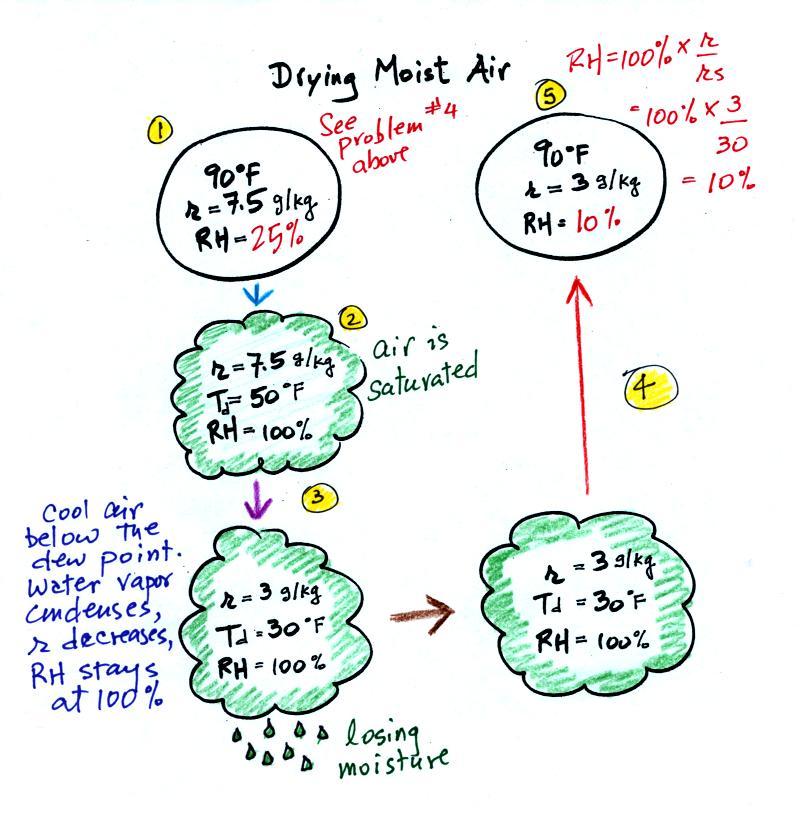
At Point 1 we start with some 90 F air with a relative humidity
of 25%, fairly dry air. These are the same numbers in
Example Problem #4. We imagine cooling this air to the dew
point temperature, 50 F. While doing that the mixing ratio,
r, would stay constant. Relative humidity would increase and
eventually reach 100%. A cloud would form (Pt. 2 in the
figure above).
Then we continue to cool the air below the dew point, to 30
F. Air that is cooled below the dew point finds itself with
more water vapor than it can contain. The excess moisture
must condense (we will assume it falls out of the air as rain or
snow). Mixing ratio will decrease, the relative humidity
will remain 100%. When air reaches 30 F it contains 3 g/kg,
less than half the moisture that it originally did (7.5
g/kg). The air is being warmed back up to 90 F along Path
4. As it warms the mixing ratio remains constant. At
Point 5, the air now has a RH of only 10%.
Drying moist air is very similar to wringing moisture from a wet
sponge.
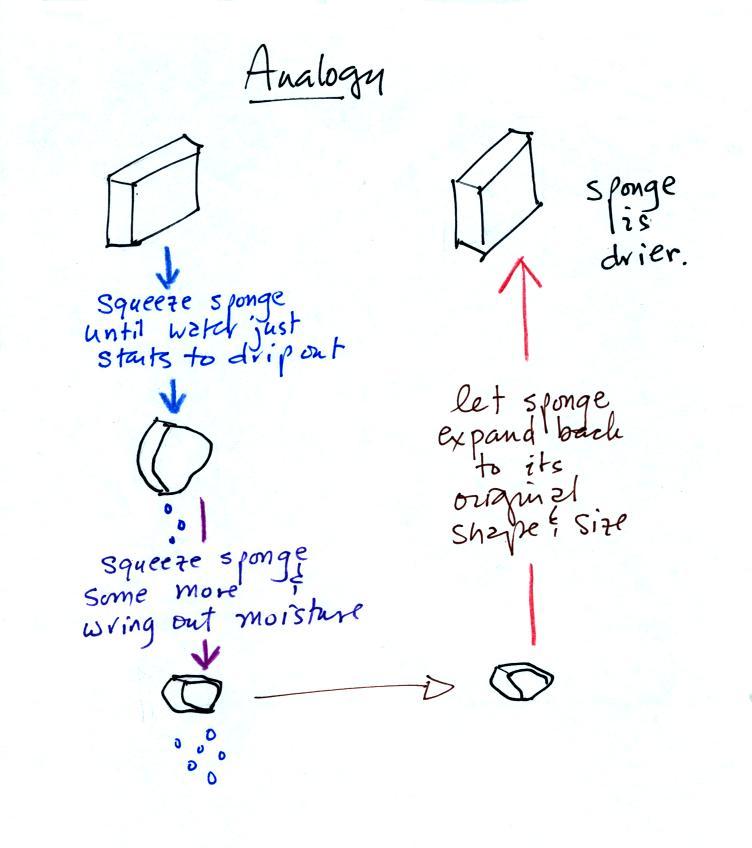
You start to squeeze the sponge and it gets
smaller. That's like cooling the air and reducing the
saturation mixing ratio, the air's capacity for water vapor.
At first squeezing the sponge doesn't cause anything to happen
(that's like cooling the air, the mixing ratio stays constant as
long as the air doesn't lose any water vapor). Eventually
water will start to drop from the sponge (with air this is what
happens when you reach the dew point and continue to cool the air
below the dew point). Then you let go of the sponge and let
it expand back to its original shape and size (the air warms back
to its original temperature). The sponge (and the air) will
be drier than when you started.
Dry air indoors in the winter
The air indoors in the winter is often quite dry.
In the winter cold air is brought inside your house or
apartment and warmed. Imagine 30 F air with a RH of 100%
(this is a best case scenario, the cold air outdoors usually has a
relative humidity less than 100% and is drier). Bringing the air
inside and warming it will cause the RH to drop from 100% to
20%.. This can cause chapped skin, can irritate nasal
passages, and causes cat's fur to become charged with static
electricity. Cooling moist air increases the relative
humidity, warming moist air lowers the RH.
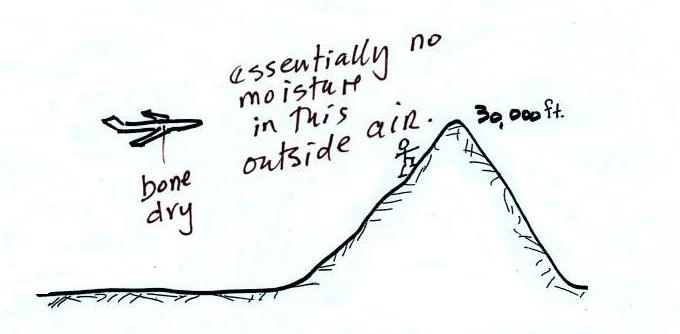
The air in an airplane comes from outside
the plane. The air outside the plane can be very cold
(-60 F perhaps) and contains very little water vapor (even
if the -60 F air is saturated it would contain essentially
no water vapor). When brought inside and warmed
to a comfortable temperature, the RH of the air in the plane
will be essentially 0%. Passengers often complain of dehydration
on long airplane flights. This may
increase the risk of catching a cold (ref)
The rain-shadow effect
Next a much more important example
of drying moist air (see p. 88 in the photocopied
ClassNotes).
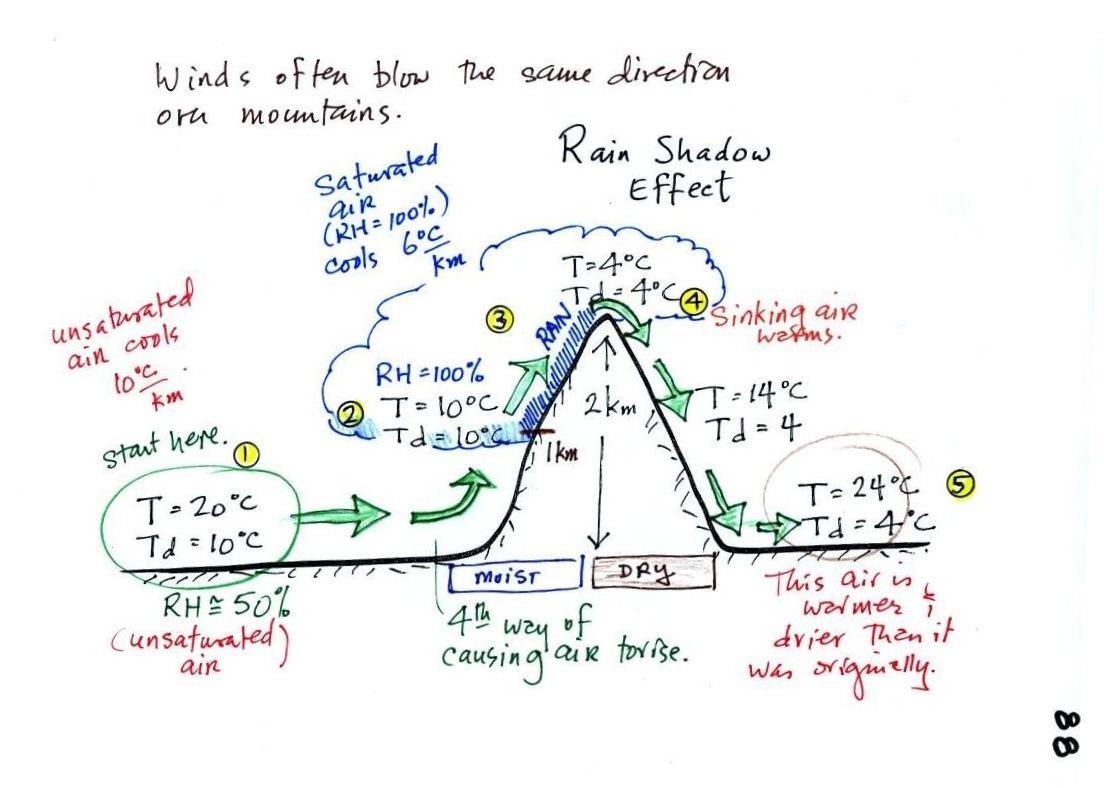
We start with some moist but unsaturated air (the RH
is about 50%) at Point 1 (the air and dew point temperatures
would need to be equal in order for the air to be saturated). As it is
moving toward the right the air runs into a mountain and
starts to rise* (see
below). Rising air
expands and cools. Unsaturated air cools 10 C for every
kilometer of altitude gain (this is known as the dry adiabatic
lapse rate but isn't something you need to remember). So
after rising 1 km the air will cool to 10 C which is the dew
point.
The air becomes saturated at Point 2 (the air temperature and
the dew point are both 10 C). Would you be able to tell
if you were outdoors looking at the mountain? Yes, you
would see a cloud appear.
Now that the RH = 100%, the saturated air cools at a slower
rate than unsaturated air (condensation of water vapor
releases latent heat energy inside the rising volume of air,
this warming partly offsets the cooling caused by
expansion). We'll use a value of 6 C/km (an average
value). The air cools from 10 C to 4 C in next kilometer
up to the top of the mountain. Because the air is being
cooled below its dew point at Point 3, some of the water vapor
will condense and fall to the ground as rain. Moisture
is being removed from the air and the value of the mixing
ratio (and the dew point temperature) decreases.
At Point 4 the air starts back down the right side of the
mountain. Sinking air is compressed and warms. As
soon as the air starts to sink and warm, the relative humidity
drops below 100% and the cloud disappears. The sinking
unsaturated air will warm at the 10 C/km rate.
At Point 5 the air ends up warmer (24 C vs 20 C) and drier (Td
= 4 C vs Td = 10 C) than when it started out. The
downwind side of the mountain is referred to as a "rain
shadow" because rain is less likely there than on the upwind
side of the mountain. Rain is less likely because the
air is sinking and because the air on the downwind side is
drier than it was on the upslope side.
Question #6 on today's
class handout is a fairly difficult rain-shadow effect
question.
*This is
topographic lifting, the 4th of 4 processes that can cause air
to rise. The other three were: convergence (surface
winds spiraling inward toward a low pressure center will
rise), fronts (both warm and cold fronts cause air to rise),
and convection (warm air rises)
|
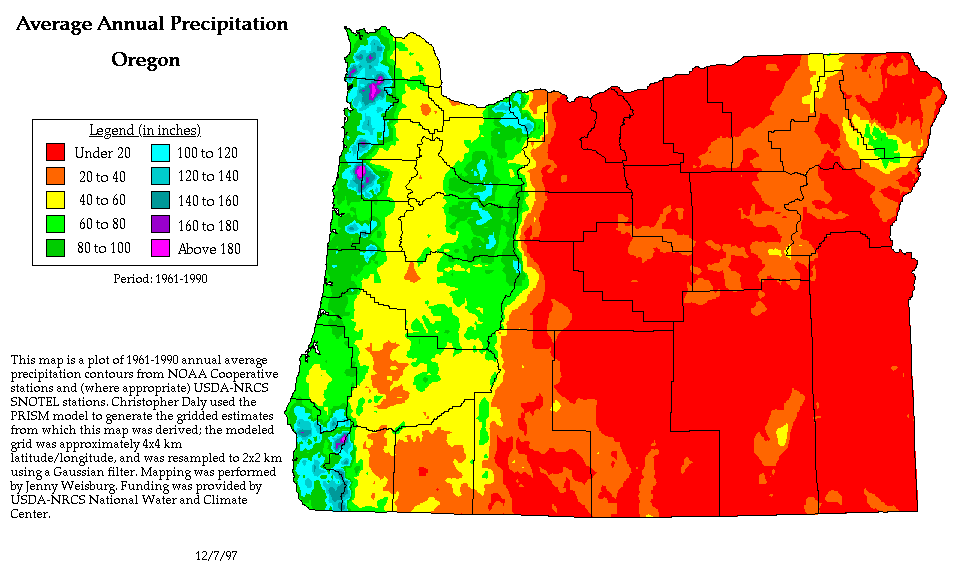 |
We can see the effects of a rain shadow illustrated
well in the state of Oregon. The figure above at left
shows the topography (here's the source
of that map). Winds generally blow from west
to east across the state.
Coming off the Pacific Ocean the winds first encounter a
coastal range of mountains. On the precipitation map
above at right (source)
you see a lot of greens and blue on the western sides of the
coastal range. These colors indicate yearly rainfall
totals that range from about 50 to more than 180 inches of
rain per year. Temperate rainforests are found in some
of these coastal locations.
That's the Willamette River, I think, in between the coastal
range and the Cascades. This valley is somewhat drier
than the coast because air moving off the Pacific has lost
some of its moisture moving over the coastal range.
What moisture does remain in the air is removed as the winds
move up and over the taller Cascades. Yearly rainfall is
generally less than 20 inches per year on the eastern side,
the rain shadow side, of the Cascades. That's not too
much more than Tucson which averages about 12 inches of rain a
year.
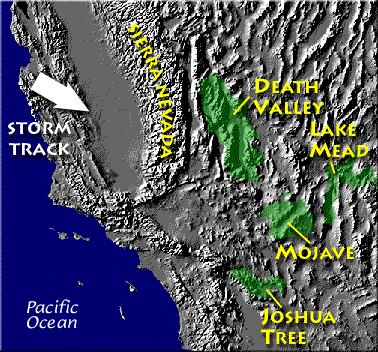 |
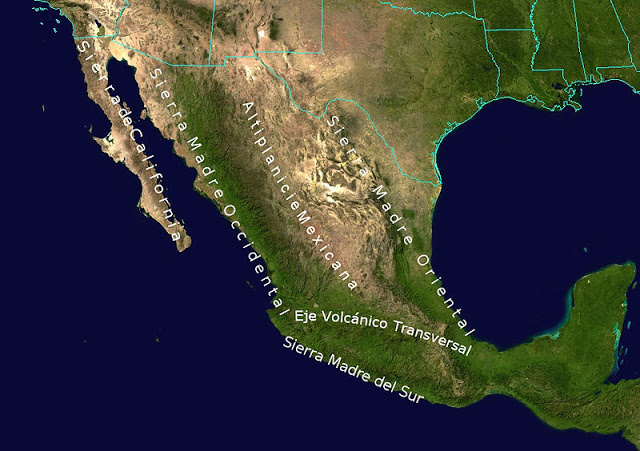 |
Death valley is found
on the downwind side of the Sierra Nevada mountains (source of
left image).
The Chihuahuan desert and the Sonoran
desert are found downwind of the Sierra Madre mountains in
Mexico (source
of the right image)
Most of the year the air that arrives in Arizona
comes from the west, from the Pacific Ocean (this changes in
the summer). It usually isn't very moist by the time it
reaches Arizona because it has traveled up and over the Sierra
Nevada mountains in California and the Sierra Madre mountains
further south in Mexico. The air loses much of its
moisture on the western slopes of those mountains.
Beginning in early July in southern Arizona we start to get
air coming from the south or southeast. This air can be
much moister and leads to development of our summer
thunderstorms.
Just as some of the world's driest regions are
found on the downwind side (the rain shadow side) of mountain
ranges, some of the wettest locations on earth are on the
upwind sides of mountains. There seems to be some debate
whether Mt.
Wai'ale'ale in Hawaii or Cherrapunji
India gets the most rain per year. Both get
between 450 and 500 inches of rain per year.
Measuring humidity with a sling
psychrometer
Next in today's potpourri of topics was a short
discussion of how you might measure humidity. One of the
ways is to use a sling (swing might be more descriptive)
psychrometer.
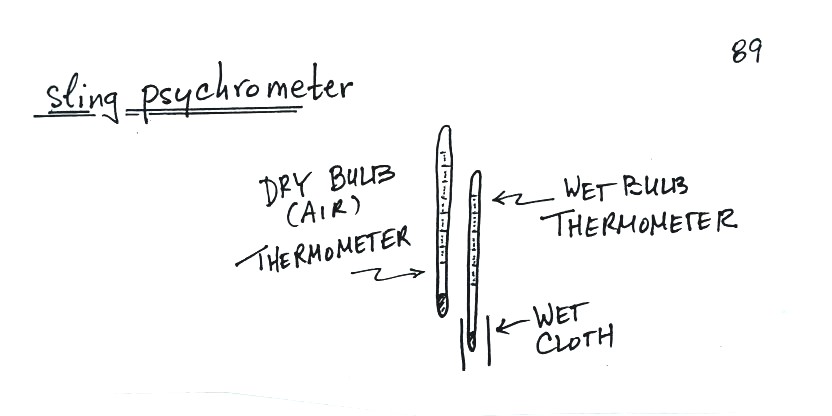
A
sling psychrometer consists of two thermometers
mounted side by side. One is an ordinary
thermometer, the other is covered with a wet
piece of cloth. To make a humidity
measurement you swing the psychrometer around
for a minute or two and then read the
temperatures from the two thermometers.
The dry thermometer measures the air
temperature.
Would the wet thermometer be warmer or colder or
the same as the dry thermometer? You
can check it out for yourself - go get one of
your hands wet. Does it feel the same as
the dry hand? You might blow on both hands
to increase the evaporation from the wet
hand. I think you'll find the wet hand
feels colder. That's what happens with the
wet bulb thermometer.
|
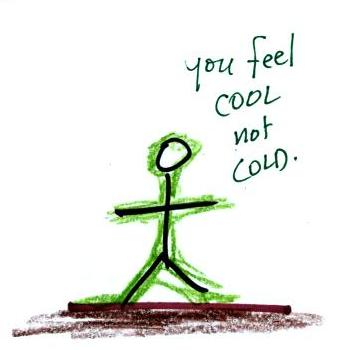
|
What could you say about the relative humidity in
these two situations (you can assume the air
temperature is the same in both pictures).
You would feel coldest on a dry day (the left
picture indicates dry air). The evaporative coolers
that many people use in Tucson in the summer work much
better (more cooling) early in the summer when the air is
dry. Once the thunderstorm season begins in July and
the air is more humid it is hard to cool your house below 80
F.
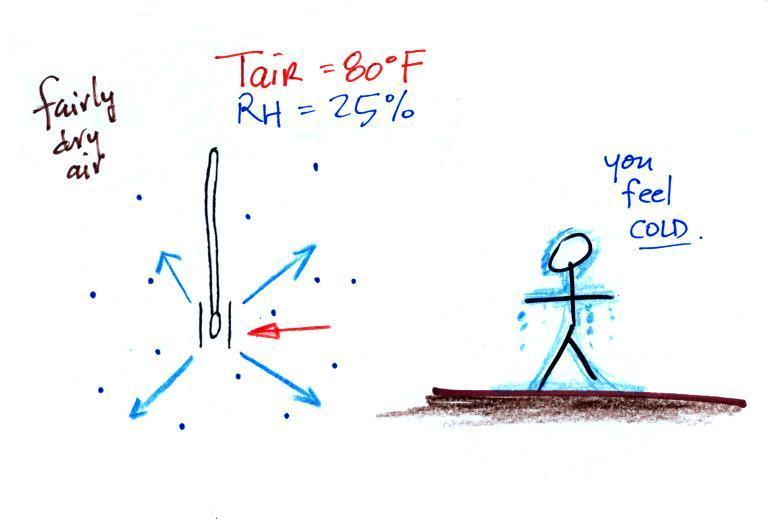
The figure shows what
will happen as you start to swing the wet bulb
thermometer. Water will begin to evaporate
from the wet piece of cloth. The amount
or rate of evaporation will depend on the water
temperature Warm water
evaporates at a higher rate than cool water (think
of a steaming cup of hot tea and a glass of ice
tea).
The evaporation is shown as blue arrows because this
will cool the thermometer. The water on
the wet thermometer starts out at 80 F and
evaporates fairly rapidly.
The figure at upper left also shows one arrow of
condensation. The amount or
rate of condensation depends on how much water
vapor is in the air surrounding the
thermometer. In this case (low relative
humidity) there isn't much water vapor. The
condensation arrow is orange because the
condensation will release latent heat and warm the
thermometer.
Because there
is more evaporation (4 arrows) than
condensation (1 arrow) the wet bulb
thermometer will drop. As the
thermometer cools the rate of evaporation
will decrease. The thermometer will
continue to cool until the evaporation has
decreased enough that it balances the
condensation.
The
rates of evaporation and
condensation are equal.
The temperature will now remain
constant.
The figure below shows the
situation on a day with higher
relative humidity. There's
enough moisture in the
air to provide 3 arrows
of condensation.
The thermometer will only cool a little bit
before
the rates of evaporation and condensation are
again equal.
Here's the all important summary picture.
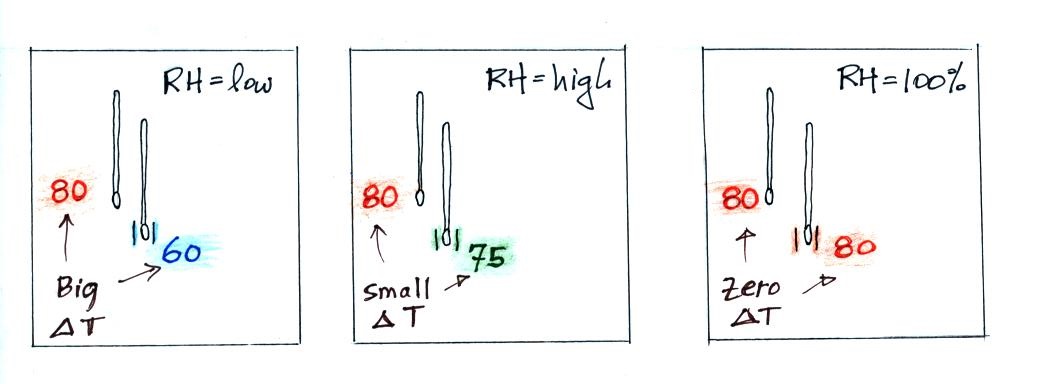
A large difference between the
dry and wet temperatures means the relative humidity
is low. A
small difference means the RH is higher. No
difference means the relative humidity is
100%.
Note the difference between air temperature and dew
point temperature follows the same kind of rule.
We were out
of time at this point but I've included a little bit more
information none the less.
Wind chill and heat index
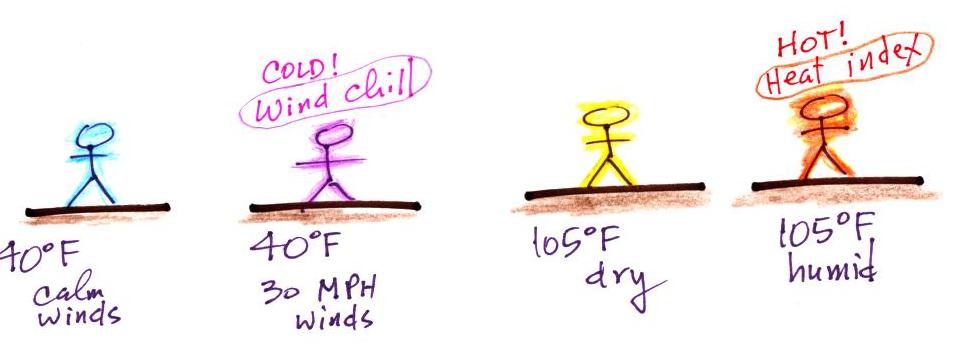
Cold temperatures and wind make it feel
colder than it really is. The wind
chill temperature tells you how much colder it will feel
( a thermometer would measure the same temperature on both the
calm and the windy day). If your body isn't able to keep
up with the heat loss, you can get hypothermia
and die.
There's something like that involving heat
and humidity. Your body tries to stay cool by
perspiring. You would feel hot on a dry 105 F day.
You'll feel even hotter on a 105 F day with high relative
humidity because your sweat won't
evaporate as quickly. The heat index
measures how much hotter you'd feel. The combination of heat
and high humidity is a serious, potentially deadly, weather
hazard because it can cause heatstroke
(hyperthermia).
